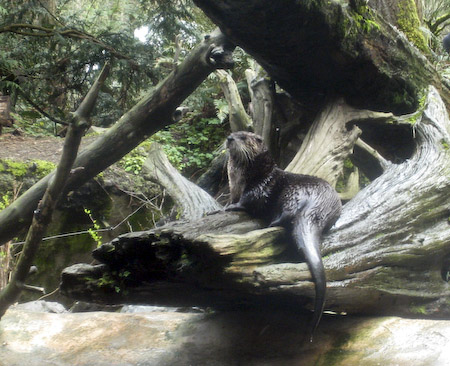|
The answer is RIVER OTTER.

Going in & out of water, sliding on its belly, eating fish, and
leaving a body imprint with a fat tail were all otter clues.
Perhaps the trickiest clue was the small size of the footprints - I have
seen other otter footprints almost twice as large, which seems to fall
in line with most field guides, so this must have been a young otter.
These tracks & sign were an especially exciting experience for me
because I never before would have believed that otters would visit a
place like this - very close to the city of Hartford, in rather
stagnant, polluted-looking lakes containing rusted hulks of junked cars,
next to a railroad.
I have learned many things from otter tracks. The most
surprising lesson I have learned is that otters are pretty robust
creatures, able to subsist in surprisingly urbanized and dirty
waterways, contrary to popular belief & info in Tom Brown's field
guide. Because otters travel from place to place primarily by swimming,
and they are capable of swimming very fast, their home range can be
huge. But they don't need very deep water to travel around; I have
seen otters (and nutrias) move thru 3" deep water by sliding on
their belly and pushing themselves along with their feet. Otters
like to do the same thing in snow, and in this case the tracks will be
very irregular, without a distinct "stride length".
Otters don't seem to have a ritual of hauling out of the water at any
specific spot - I have found that because their territory is so large
and they don't spend much time out of the water, I have to get out
tracking very often to have any chance of finding otter tracks.
The most common places I have found otter tracks is on narrow strips of
land in between two bodies of water, such as a peninsula or isthmus.
In addition to tracks, I also find "rolls" at these
haul-out spots. Otters regularly need to roll in either grass or snow to
fluff up their fur. In snow, I'll sometimes find spots where an
otter has rolled over & over, leaving a broad flattened area but no
footprints.
Otters also love to slide on their bellies. I have never found
one of those "legendary" otter slides going down a stream
bank; instead, I more commonly find belly slides on level ground.
And when otters slide, man, they just slide & slide & slide.
My observations have been that if there is snow on the ground or ice on
a lake/river, otters' preferred mode of locomotion is sliding rather
than walking or bounding. I have even found otter slides going uphill,
on gentle grades.
Field guides say that otters chew their food very thoroughly, and the
only recognizable remains in their scat are fish scales & bones, and
I concur. I have found that scat is commonly deposited at the site
of a roll, and there are theories that otter scat is a form of scent
marking. Field guides say the scat can be either dry or mucousy -
I always find it to be mucousy, and in snow the mucous bleeds out to
stain the snow. The green color to the scat of the otters in my
territory is apparently pretty unusual, it is a mystery to me what food
source in the cold season would cause that color. Field guides say
the scat can be black if it is very mucousy, or red if the otter has
eaten crayfish. |